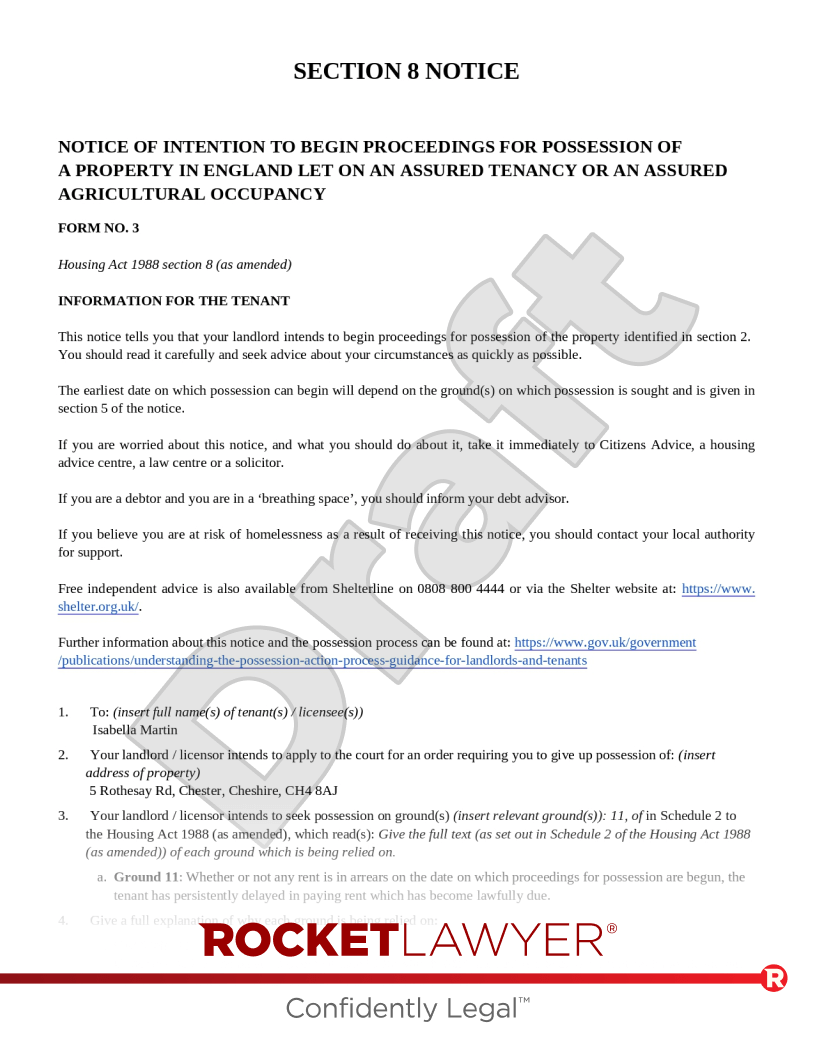MAKE YOUR FREE Eviction Notice

What we'll cover
What is an Eviction Notice?
As a landlord, there may be times when you need to give your residential tenants (known as ‘contract holders’ in Wales) notice to vacate your property using an Eviction Notice. Eviction Notices inform tenants that their tenancy is going to end and the landlord is going to take repossession of the property.
For the avoidance of doubt, references to ‘tenants’ also apply to ‘contract holders’ unless otherwise specified.
For use in England and Wales only.
When should I use an Eviction Notice?
Use this Eviction Notice to formally bring a residential tenancy in England or Wales to an end. This includes if:
-
the tenancy is coming to the end of its term
-
a tenant has breached their Tenancy agreement (eg by causing damage), or
-
a tenant is in serious rent arrears
Sample Eviction Notice
The terms in your document will update based on the information you provide
SECTION 8 NOTICE
NOTICE OF INTENTION TO BEGIN PROCEEDINGS FOR POSSESSION OF A PROPERTY IN ENGLAND LET ON AN ASSURED TENANCY OR AN ASSURED AGRICULTURAL OCCUPANCY
FORM NO. 3
Housing Act 1988 section 8 (as amended)
INFORMATION FOR THE TENANT
This notice tells you that your landlord intends to begin proceedings for possession of the property identified in section 2. You should read it carefully and seek advice about your circumstances as quickly as possible.
The earliest date on which possession can begin will depend on the ground(s) on which possession is sought and is given in section 5 of the notice.
If you are worried about this notice, and what you should do about it, take it immediately to Citizens Advice, a housing advice centre, a law centre or a solicitor.
If you are a debtor and you are in a ‘breathing space’, you should inform your debt advisor.
If you believe you are at risk of homelessness as a result of receiving this notice, you should contact your local authority for support.
Free independent advice is also available from Shelterline on 0808 800 4444 or via the Shelter website at: https://www.shelter.org.uk/.
Further information about this notice and the possession process can be found at: https://www.gov.uk/government/publications/understanding-the-possession-action-process-guidance-for-landlords-and-tenants
- To: (insert full name(s) of tenant(s) / licensee(s))
- Your landlord / licensor intends to apply to the court for an order requiring you to give up possession of: (insert address of property)
, - Your landlord / licensor intends to seek possession on ground(s) (insert relevant ground(s)): of in Schedule 2 to the Housing Act 1988 (as amended), which read(s): Give the full text (as set out in Schedule 2 of the Housing Act 1988 (as amended)) of each ground which is being relied on.
- Give a full explanation of why each ground is being relied on:
- The court proceedings will not begin earlier than: (insert a calendar date in accordance with the notice period required for the ground(s) being relied on as set out in section 8 Housing Act 1988 (as amended))
- If your landlord / licensor does not apply to the court within a given timeframe this notice will lapse. The latest date for court proceedings to begin is 12 months from the date of service of this notice, subject to any extension in accordance with the Debt Respite Scheme (Breathing Space Moratorium and Mental Health Crisis Moratorium) (England and Wales) Regulations 2020.
- Name and address of landlord, licensor or landlord’s agent:
(To be completed in full by the landlord, licensor, or, in the case of joint landlords / licensors, at least one of the joint landlords / licensors, or by someone authorised to give notice on the landlord’s / licensor’s behalf.)
| Signed | |
| Name | |
| Address | |
| Telephone number |
| Signed | |
| Name | |
| Address | |
| Telephone number |
Capacity (please tick): landlord / liscensor
joint landlord(s) / liscensor(s)
landlord's / licensor's agent
| Date |
Contains public sector information licensed under the Open Government Licence v3.0. Crown copyright. Published by Rocket Lawyer, 2024
About Eviction Notices
Learn more about making your Eviction Notice
-
How to make an Eviction Notice
Making an Eviction Notice online is simple. Just answer a few questions and Rocket Lawyer will build your document for you. When you have all of the details prepared in advance, making your document is a quick and easy process.
What information you need to make your Eviction Notice will depend on the document in question. However, the types of questions you may be asked include:
Party details
-
The landlord’s details (eg your name and address).
-
The tenant’s details (eg their name).
Property details
-
What is the address of the property?
Notice
-
Why is the tenant being evicted?
-
What is the date on which the Eviction Notice is set to expire?
-
-
Common terms in an Eviction Notice
Eviction Notices are used by landlords to regain possession of a property in England or Wales. While the terms of an Eviction Notice differ depending on the document in question, examples of common provisions include:
Information for tenants
An Eviction Notice will usually provide details of the Notice’s legal basis (ie under which act the Notice is being served). It also provides information about the eviction process and the Eviction Notice itself to the tenant.
Notice details
The body of the Eviction Notice will set out details relating to the Notice itself, including:
-
the tenant’s details
-
the address of the property the tenant is renting
-
the expiry date of the Notice
-
-
Legal tips for making an Eviction Notice
Make sure you use the right document for your needs
Various Eviction Notices exist and you should make sure to create one that is suitable for your needs and circumstances. Not only should you base this on the country the rental property is in (ie England or Wales), but should also reflect why you are asking the tenant to leave. Using the incorrect document may cause problems down the line. For more information, read the FAQ ‘What type of Eviction Notice should I use?’ and our guides on Repossessing property - section 21 notices, Repossessing property - section 8 notices and Repossessing property in Wales.
Understand when to seek advice from a lawyer
Ask a lawyer if:
-
you’re unsure about what Eviction Notice you should use
-
your document doesn’t meet your specific needs
-
you need an Eviction Notice for Scotland
-
Eviction Notice FAQs
-
What is included in an Eviction Notice?
This Eviction Notice template covers:
-
the landlord’s details
-
the tenant’s (or contract holder’s) details
-
the ground for eviction
-
the eviction notice period
-
relevant information onevictions
-
-
Why do I need an Eviction Notice?
If you need to regain possession of your property, either because of something the tenant did (eg failing to pay the rent) or despite their not having done anything wrong, you must use an Eviction Notice. You need to make sure that you use the correct Eviction Notice to legally evict tenants.
By using the appropriate Eviction Notice, you ensure that you are evicting the tenant correctly and ensure that you can re-let the property easily and without any delays.
-
What type of Eviction Notice should I use?
There are various ways of repossessing property - including section 21 and section 8 notices in England and section 173 and section 188/182 notices in Wales. Using the correct Eviction Notice template will help to ensure that you take possession of the property safely and legally.
England - section 21 notices
You should use a Section 21 (form 6A) notice to gain possession of a rental property when the property is let under an assured shorthold tenancy (AST).
You can use a section 21 notice for a rolling tenancy when the tenant has failed to pay rent for several months. You can also serve a section 21 notice if you want to end a tenancy on a no-fault basis (eg after the end of a fixed-term tenancy).
England - section 8 notices
You can use a Section 8 notice to evict tenants who are in breach of their tenancy agreements. Section 8 notices can be served during the fixed term if there are specific reasons for doing so. These are also known as 'grounds' for possession. These include situations where tenants have not paid their rent or have caused damage to the property. You can rely on multiple grounds of possession.
Wales - section 173 notices
You should use a Section 173 notice to end a periodic standard contract. You can generally only use a section 173 notice to end a contract after the first 6 months and when you have not broken your responsibilities as a landlord.
Wales - section 188 or 182 notices
You can use a Section 188 notice to end a fixed-term standard contract for serious rent arrears. Similarly, you can use a Section 182 notice to end a periodic standard contract for serious rent arrears. Whether a rent arrears is serious depends on how regularly the rent is paid. For example, for monthly contracts, at least 2 months’ rent must be unpaid. Read Repossessing property in Wales to find out more.
Scotland
In Scotland, tenants can only be evicted if at least one of 18 eviction grounds applies. These Eviction Notices should not be used in Scotland. If you require an Eviction Notice for Scotland, Ask a lawyer.
-
How much notice should I give the tenant?
This will depend on where the property is located and the type of Eviction Notice you are using to end the tenancy.
England
If you use a section 21 notice, you must give the tenant a minimum notice period of 2 months. This means the tenant must physically receive the notice 2 months before they have to move out.
If you use a section 8 notice, the required notice period will depend on the ground you base the notice on. For example, 2 weeks’ notice is required for grounds 8, 10 and 11.
For more information, read Repossessing property - section 21 notices and Repossessing property - section 8 notices.
Wales
If you use a section 173 notice, you must typically give contract holders at least 6 months’ notice.
If you use a section 188 or 182 notice, you have to give contract holders at least 14 days’ notice of your intention to start a repossession claim. If the contract holder has not moved out after the notice period (and rent continues to be owed), you can apply to the courts for a possession order.
For more information, read Repossessing property in Wales.
For more information on repossessions in general, read Tenant eviction.

Our quality guarantee
We guarantee our service is safe and secure, and that properly signed Rocket Lawyer documents are legally enforceable under UK laws.
Need help? No problem!
Ask a question for free or get affordable legal advice from our lawyer.




